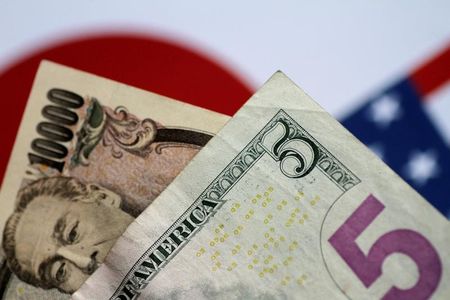
Investing.com– Most Asian currencies steadied from recent losses on Thursday with the Japanese yen remaining close to near three-month lows, while the dollar remained underpinned by expectations of slower interest rate cuts.
Regional currencies were battered by increased risk aversion in markets, as anticipation of a tight U.S. presidential race also kept traders on edge, as did heightened concerns in the Middle East.
Risk aversion benefited the dollar and gold. But the Japanese yen saw little safe haven demand, amid doubts over just how much headroom the Bank of Japan has to keep raising interest rates.
Broader Asian currencies were also skittish as traders awaited more cues on stimulus measures in China.
Japanese yen steadies amid intervention warnings
The Japanese yen’s USDJPY pair fell slightly on Thursday after racing to a near three-month high in the prior session.
The yen saw some support after Japanese government officials warned against “one-sided” moves in currency markets, in light of recent weakness in the yen. Their comments spurred some fears of currency market intervention.
The yen took few cues from weak purchasing managers index data, which showed a contraction in business activity in October.
The yen remained fragile amid growing doubts over more rate hikes by the BOJ, especially in anticipation of Japanese general elections this Sunday.
The ruling Liberal Democratic Party could potentially need to seek a coalition to maintain power, shifting Japan’s political landscape and limiting the BOJ’s ability to make changes in monetary policy.
The BOJ is set to meet next week and is widely expected to keep rates steady. Before that, consumer inflation data from Tokyo is due on Friday.
Dollar strong as yields rise amid bets on smaller rate cut
The dollar index and dollar index futures fell slightly in Asian trade, but remained close to near three-month highs. Gains in the dollar came tracking a sharp increase in Treasury yields.
The greenback was boosted by growing bets that the Fed will cut rates by a smaller 25 basis points in November, amid persistent signs of resilience in the U.S. economy.
PMI data due later in the day is expected to provide more cues on that front.
On the election front, improved odds for Republican nominee Donald Trump also buoyed the dollar, on bets that his policies will be inflationary.
Broader Asian currencies firmed slightly on Thursday as they recouped some recent losses.
The Australian dollar’s AUDUSD pair rose 0.2% after mixed PMI data, while the South Korean won’s USDKRW pair was flat after weaker-than-expected gross domestic product data showed the economy barely grew in the third quarter.
The Chinese yuan’s USDCNY pair fell 0.2%, recovering slightly from a near two-month high hit earlier this week.
The Singapore dollar’s USDSGD pair fell 0.1%, while the Indian rupee’s USDINR pair fell slightly from near record highs.
This post is originally published on INVESTING.


